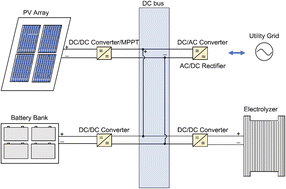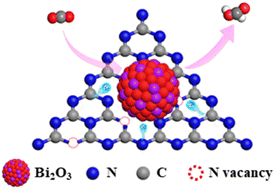Themed collection Sustainable Energy & Fuels Emerging Investigators Series

Selective hydrogenation of lignocellulosic biomass over single-atom catalysts
Single-atom catalysis for lignocellulosic biomass refinery for fuels and chemicals provides a new insight and improved catalytic performances for the sustainable development of the society.

Sustainable Energy Fuels, 2023,7, 2974-2990
https://doi.org/10.1039/D3SE00454F
In situ growth of a heterojunction CdS/TiO2 nanofiber monolithic photocatalyst sheet for enhanced hydrogen evolution
A heterojunction CdS/TiO2 nanofiber monolithic photocatalyst sheet was developed via facile in situ hydrothermal growth on Ti foil. The photocatalyst sheet can greatly enhance photocatalytic H2 production.

Sustainable Energy Fuels, 2023,7, 1371-1376
https://doi.org/10.1039/D2SE01783K
Oxalate metal–organic framework derived atomic Ru3+-doped Co(OH)2 nanosheets for a highly efficient hydrogen evolution reaction
Oxalate metal–organic framework derived atomic Ru3+-doped Co(OH)2 nanosheets are fabricated for highly efficient hydrogen evolution reaction, showing a very small overpotential of 36 mV at 30 mA cm−2 in 1.0 M KOH.

Sustainable Energy Fuels, 2023,7, 928-933
https://doi.org/10.1039/D2SE01664H
In situ oxidative etching-enabled synthesis of hollow Cu2O nanocrystals for efficient CO2RR into C2+ products
The prepared hollow Cu2O nanocrystals via oxidative etching yield C2+ products with a faradaic efficiency of 75.9% and a C2+ partial current density of 0.54 A cm−2 ascribed to their defect-rich sites and abundant stepped facets.

Sustainable Energy Fuels, 2022,6, 4860-4865
https://doi.org/10.1039/D2SE01174C
Decentralised production of e-fuels for aviation: implications and trade-offs of a targeted small-scale production of sustainable aviation fuel based on Fischer–Tropsch synthesis
The introduction of Sustainable Aviation Fuel (SAF) is expected to play an important role in the decarbonisation of the aviation sector.

Sustainable Energy Fuels, 2024,8, 752-765
https://doi.org/10.1039/D3SE01156A
Nickel single atom catalyst supported on the gallium nitride monolayer: first principles investigations on the decisive role of support in the electrocatalytic reduction of CO2
First principles investigations on the modulation of electronic structure of Ni based SAC by varrying the nature and type of support for CO2 reduction to C1 products.

Sustainable Energy Fuels, 2023,7, 5046-5056
https://doi.org/10.1039/D3SE00830D
Energy-dense anode-free rechargeable lithium metal batteries based on thick cathodes and pulse charging strategies
In combination with a thick cathode and pulse charging strategies, anode-free lithium metal batteries demonstrated reduced polarization at 5 mA cm−2 and a capacity retention of 79.4% after 50 cycles.

Sustainable Energy Fuels, 2023,7, 4442-4449
https://doi.org/10.1039/D3SE00664F
Methylated precursor leads to carbon nitride (CNx) with improved interfacial interactions for enhanced photocatalytic performance
Methylated precursors used in a facile CNx copolymerization synthesis yield modified CNx materials with better aqueous dispersibility properties for enhanced photoactivity.

Sustainable Energy Fuels, 2023,7, 3250-3265
https://doi.org/10.1039/D2SE01636B
Sector coupling leading to low-carbon production of power and chemicals in China
A pathway to a carbon-neutral electricity-chemical nexus in China by 2060 is attainable. Sector coupling reduces fossil power generation by 10%, drives renewable curtailment rates to below 5%, and expands energy transmission capacity by at most 18%.

Sustainable Energy Fuels, 2023,7, 2130-2145
https://doi.org/10.1039/D2SE01749K
Optimal design of a coupled photovoltaic–electrolysis-battery system for hydrogen generation
A computational algorithm to model a coupled solar-hydrogen system is presented. The results demonstrated that optimizing the system's cost and hydrogen production rate implicitly ensures the levelized cost of energy is minimized.

Sustainable Energy Fuels, 2023,7, 1395-1414
https://doi.org/10.1039/D2SE01555B
Subsurface oxygen reduction reaction activity on Ti2N MXene revealed by in situ Raman spectroelectrochemistry
In situ Raman spectroscopy reveals that the subsurface of Ti2N nitride MXene is the active site for oxygen reduction reaction. We also report that the Ti2N MXene is more active than Ti3C2 MXene and more stable than Ti3C2 and 10% Pt/C.

Sustainable Energy Fuels, 2023,7, 956-964
https://doi.org/10.1039/D2SE01532C
Stable Cs2ReX6 (X – Cl, Br) vacancy-ordered perovskites for solar water splitting
We report one of the most stable vacancy-ordered perovskites Cs2ReX6 (X – Cl, Br) that show panchromatic visible absorption and demonstrated excellent acid/base stability, which enabled them to be employed as photoanodes for solar water oxidation.

Sustainable Energy Fuels, 2023,7, 949-955
https://doi.org/10.1039/D2SE01281B
Supported rhenium catalysts for the hydrogenation of levulinic acid derivatives: limits and potential
Levulinic acid derivatives, such as alkyl levulinates, are suitable starting reactants for the production of fuel components, namely γ-valerolactone (GVL), alkyl valerates, pentanol, and pentylvalerate (PV).

Sustainable Energy Fuels, 2023,7, 671-681
https://doi.org/10.1039/D2SE01583H
PEO composite solid polymer electrolytes with the synergistic effect of cryogenic engineering and trace BP nanosheets for nearly room temperature and 4 V class all-solid-state lithium batteries
A novel PEO-based SPE with a synergistic effect of black phosphorus (BP) nanosheets and a cryogenic method, which can combine the advantages of the fast Li+ pathways of BP nanosheets and the low PEO crystallization of cryogenic method.

Sustainable Energy Fuels, 2023,7, 652-660
https://doi.org/10.1039/D2SE01524B
Tuning B–N pairs in porous carbon nanorods for electrochemical conversion of CO2 to syngas with controllable CO/H2 ratios
Through modulating the contents of the N/B dopants and corresponding B–N pairs for the NBCs, the syngas generation with tunable CO/H2 ratios from 12.3 to 1 under different potentials can be realized.

Sustainable Energy Fuels, 2023,7, 661-670
https://doi.org/10.1039/D2SE01423H
The surface-sulphurated Co3O4 nanowire array electrocatalyst for oxygen evolution reaction and water-splitting applications
A surface-sulphurated cobalt oxide electrocatalyst with a nanowire array integrated structure is designed for oxygen evolution reaction and water-splitting applications.

Sustainable Energy Fuels, 2023,7, 389-397
https://doi.org/10.1039/D2SE01470J
Phase junction crystalline carbon nitride nanosheets modified with CdS nanoparticles for photocatalytic CO2 reduction
PTI–melon molecular junctions anchored with CdS nanoparticles enable efficient CO2 photoreduction, affording a high AQE of 10.8% at 420 nm.

Sustainable Energy Fuels, 2023,7, 381-388
https://doi.org/10.1039/D2SE01576E
Out-of-plane transient thermal conductivity measurements for bulk semiconducting conjugated polymers using fast scanning calorimetry
The thermal conductivity for CP was enhanced with 5 wt% dopants but impaired with more than 20 wt% dopants. The enhanced thermal conductivity was attributed to higher rDOC and stronger π–π interactions due to small amount of active dopants.

Sustainable Energy Fuels, 2023,7, 369-380
https://doi.org/10.1039/D2SE01413K
Creating an electron-rich region on ultrafine Bi2O3 nanoparticles to boost the electrochemical carbon dioxide reduction to formate
Metal–support interfacial interactions can enrich the electron density of Bi2O3 effectively facilitating *COO intermediate generation and boosting catalytic activity.

Sustainable Energy Fuels, 2023,7, 106-111
https://doi.org/10.1039/D2SE01274J
About this collection
Sustainable Energy & Fuels is proud to present our Emerging Investigators Series, highlighting the very best work from researchers in the early stages of their independent careers.
The collection showcases research from early career energy scientists who are working towards making future energy technologies more sustainable, in line with UN Sustainable Development Goal 7 and the scope of Sustainable Energy & Fuels. Congratulations to all the featured researchers!
This collection will be updated when new Emerging Investigator Series papers are published – so keep checking this page and watch the collection grow.